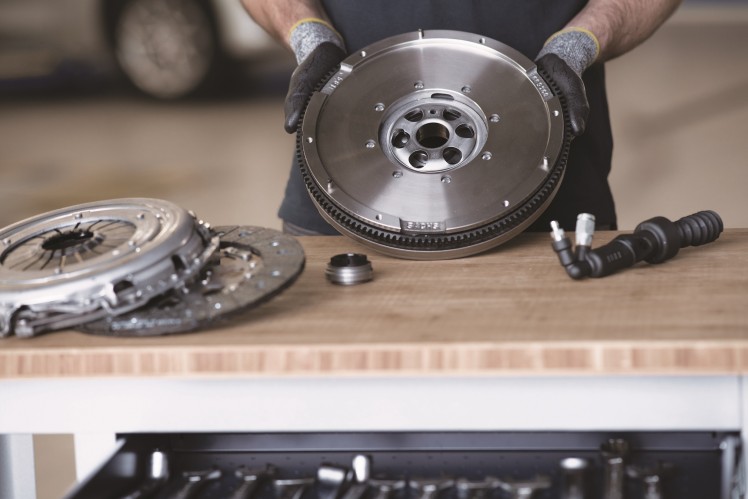What to keep in mind when assembling the clutch - The complexity of the clutch assembly is often underestimated
- Avoid unnecessary and costly whole unit repairs by seeking expert advice prior to change
- Damage to the clutch can have serious consequences for the transmission
- Pay strict attention to installation position, lateral run-out, centering and cleanliness
Clutch assembly is demanding and time-consuming as it requires the transmission to be separated from the engine. To avoid often unnecessary and costly replacement of the entire unit, prior assessment is indispensable. This is where ZF Aftermarket can dispense its expert opinion to the workshops, helping to avoid error particularly with regard to clutch disk installation.

The clutch is the link between the engine and transmission – and one of the most durable wear parts. There are many factors which can result in a clutch defect. For example, the clutch is frequently placed under heavy load due to frequent driving with a trailer or a faulty engine management system. Before replacing the entire unit at great cost, the specialists at ZF Aftermarket advise you to always check the surrounding components in the event of clutch malfunctions – including the clutch actuation and the seals of the engine, flywheel and transmission. The business recommends the Sachs clutch kit in this instance as it contains all the necessary parts for a fast and safe repair.
Examining the clutch disk before assembly
The clutch disk, also known as the drive plate, is subjected to the greatest load, because the clutch's mode of operation results in mechanical abrasion. For this reason, the clutch disk must have high wear and high temperature resistance. Sachs clutch disks from ZF Aftermarket are manufactured to the highest OE production standards and are also specifically tested for free travel. However, it makes sense to double check the condition of the packaging and the new part before installation, as it may have been damaged during transport or because of improper handling. To be completely certain of the condition of the part, make sure that the lateral run-out of the disk does not exceed the limit value of 0.5 millimeters. If it does, this can be corrected using a straightening fork. The required hand tool is included in the Sachs lateral run-out tester, which makes testing quick and easy.
Pay attention to the installation position and precisely center the clutch disk
Make sure when installing the clutch disk it is in the right position. Incorrect installation would result in damage to the disk itself, its hub spline, release lever or even to the transmission. Fitting instructions can usually be found on the component side. If no indications can be found, compare the new part with the old one before installation.
The new clutch disk must be precisely centered to prevent damage to the hub spline. There is a tolerance range of only a few hundredths of a millimeter between the transmission input shaft and the hub spline. Even small inaccuracies during insertion of the transmission input shaft can prevent the mobility later required for disengaging the clutch. The hub spline must slide onto the transmission shaft without resistance.
ZF Aftermarket recommends greasing the hub spline with Sachs high-performance grease. Its viscous consistency and temperature resistance means it adheres to the spline during operation without spreading. In order to prevent clutch shudder when the clutch is later disengaged, excess grease must always be removed, and care must be taken to keep the clutch linings absolutely clean.
Products in OEM quality
For maximum safety and performance, ZF Aftermarket recommends OEM quality products are used in the service and repair of safety critical systems. Tested to the extreme, both in the lab and on the road, Sachs clutch disks are manufactured using high-quality, state of the art materials and while the clutch kits make the change process quick and easy. They are suitable for all repairs, as they contain everything, the technician needs such as Dual Mass Flywheels (DMFs) or pressure plates. In addition, ZF Aftermarket supports its partners with comprehensive technical information and a practice-oriented training program.
- The complexity of the clutch assembly is often underestimated
- Avoid unnecessary and costly whole unit repairs by seeking expert advice prior to change
- Damage to the clutch can have serious consequences for the transmission
- Pay strict attention to installation position, lateral run-out, centering and cleanliness
Clutch assembly is demanding and time-consuming as it requires the transmission to be separated from the engine. To avoid often unnecessary and costly replacement of the entire unit, prior assessment is indispensable. This is where ZF Aftermarket can dispense its expert opinion to the workshops, helping to avoid error particularly with regard to clutch disk installation.

The clutch is the link between the engine and transmission – and one of the most durable wear parts. There are many factors which can result in a clutch defect. For example, the clutch is frequently placed under heavy load due to frequent driving with a trailer or a faulty engine management system. Before replacing the entire unit at great cost, the specialists at ZF Aftermarket advise you to always check the surrounding components in the event of clutch malfunctions – including the clutch actuation and the seals of the engine, flywheel and transmission. The business recommends the Sachs clutch kit in this instance as it contains all the necessary parts for a fast and safe repair.
Examining the clutch disk before assembly
The clutch disk, also known as the drive plate, is subjected to the greatest load, because the clutch's mode of operation results in mechanical abrasion. For this reason, the clutch disk must have high wear and high temperature resistance. Sachs clutch disks from ZF Aftermarket are manufactured to the highest OE production standards and are also specifically tested for free travel. However, it makes sense to double check the condition of the packaging and the new part before installation, as it may have been damaged during transport or because of improper handling. To be completely certain of the condition of the part, make sure that the lateral run-out of the disk does not exceed the limit value of 0.5 millimeters. If it does, this can be corrected using a straightening fork. The required hand tool is included in the Sachs lateral run-out tester, which makes testing quick and easy.
Pay attention to the installation position and precisely center the clutch disk
Make sure when installing the clutch disk it is in the right position. Incorrect installation would result in damage to the disk itself, its hub spline, release lever or even to the transmission. Fitting instructions can usually be found on the component side. If no indications can be found, compare the new part with the old one before installation.
The new clutch disk must be precisely centered to prevent damage to the hub spline. There is a tolerance range of only a few hundredths of a millimeter between the transmission input shaft and the hub spline. Even small inaccuracies during insertion of the transmission input shaft can prevent the mobility later required for disengaging the clutch. The hub spline must slide onto the transmission shaft without resistance.
ZF Aftermarket recommends greasing the hub spline with Sachs high-performance grease. Its viscous consistency and temperature resistance means it adheres to the spline during operation without spreading. In order to prevent clutch shudder when the clutch is later disengaged, excess grease must always be removed, and care must be taken to keep the clutch linings absolutely clean.
Products in OEM quality
For maximum safety and performance, ZF Aftermarket recommends OEM quality products are used in the service and repair of safety critical systems. Tested to the extreme, both in the lab and on the road, Sachs clutch disks are manufactured using high-quality, state of the art materials and while the clutch kits make the change process quick and easy. They are suitable for all repairs, as they contain everything, the technician needs such as Dual Mass Flywheels (DMFs) or pressure plates. In addition, ZF Aftermarket supports its partners with comprehensive technical information and a practice-oriented training program.
MEDIA
CONTACT

Jessica Seufert

